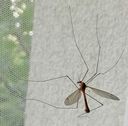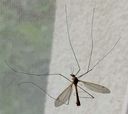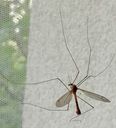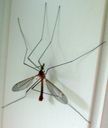Marsh Crane Fly
Tipula oleracea
Classification
- Phylum: Arthropoda
- Subphylum: Hexapoda
- Class: Insecta
- Order: Diptera
- Infraorder: Tipulomorpha
- Family: Tipulidae
- Subfamily: Tipulinae
- Genus: Tipula
- Species: oleracea
Pronunciation
How to pronounce Tipula oleracea: /tɪˈpjuːlə oʊləˈreɪʃiə/
These audio files are automatically generated. While they are not always 100% accurate, they are a good starting point.
Images






Summary
Tipula oleracea, commonly known as the Marsh Crane Fly, is a species of crane fly found primarily in the Palaearctic region and introduced to certain parts of the Nearctic. It has a significant ecological role and can impact agriculture as its larvae feed on plant roots.
Physical Characteristics
Adults: 2.5-3.0 cm long, pupae 3.0-3.5 cm, mature larvae 3-4 cm and eggs 1.0 x 0.5 mm. Generally a greyish species, abdomen may be ferruginous with blackish median and/or lateral longitudinal stripes. Wing length is 18–28 mm. 13-segmented antennae.
Identification Tips
Male tergite 9 has a short median projection, roundly bifurcated at the apex. Female wings reach the tip of the abdomen.
Habitat
Wet meadows, gardens, and cultural areas with loose, moist soil.
Distribution
Found throughout Europe, except for Finland and Latvia. Also found in parts of North America, specifically from British Columbia to California and from Michigan to New York. Introduced in Ecuador.
Diet
Larvae feed on decaying vegetable matter and delicate roots; adults feed only on liquid foods such as nectar.
Life Cycle
Eggs hatch after about 15 days. Larvae develop through four instars over about four months. The entire life cycle from egg to adult takes up to eight months.
Reproduction
Female can lay up to 1200 eggs, typically in loose, moist soil. Larvae can live in high densities, causing crop damage.
Ecosystem Role
As larvae, they can affect plant roots and can cause crop damage. Adults serve as pollinators due to their feeding habits.
Economic Impact
Mass attacks by larvae can damage crops such as cabbage.
Tags
- Tipula oleracea
- Marsh Crane Fly
- Diptera
- Tipulidae
- invasive species